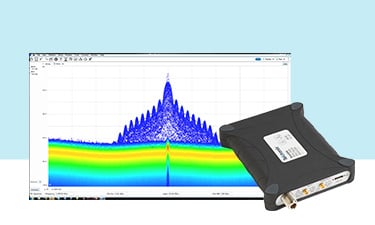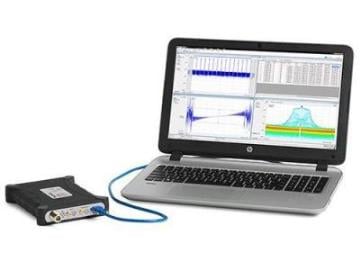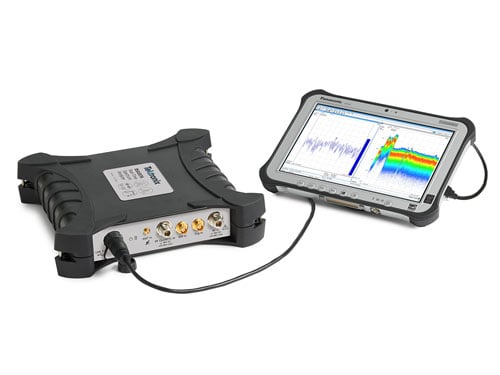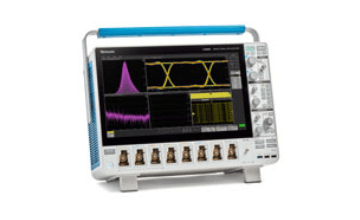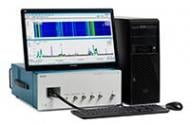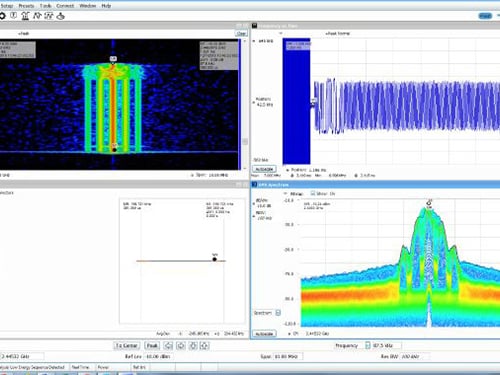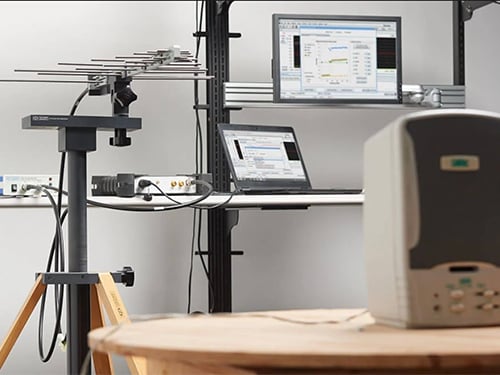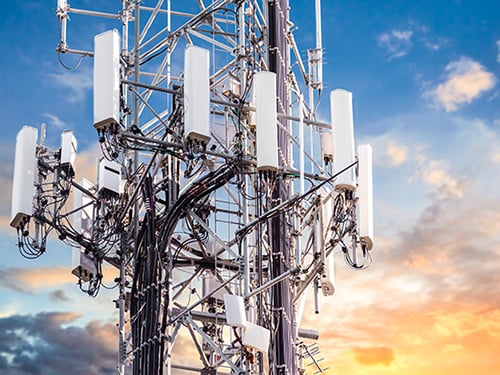Contactez-nous
Chat en direct avec un représentant Tek. Service disponible de 9 h à 17 h, CET jours ouvrables.
Appelez-nous au
Disponible de 9 h à 17 h CET jours ouvrables.
Télécharger
Télécharger des manuels, des fiches techniques, des logiciels, etc. :
Feedback
Comprendre les tests de radiofréquences : la clé du succès des systèmes sans fil
Les tests de radiofréquences (RF) consistent à mesurer et à analyser les ondes électromagnétiques utilisées pour transmettre des signaux dans une variété d'applications, de la communication sans fil à la radiodiffusion en passant par les radars et les systèmes satellitaires. Les tests RF consistent à évaluer les performances, la force et la qualité de ces signaux afin de s'assurer qu'ils répondent à des normes et à des exigences spécifiques. Ceci est essentiel pour le développement, la validation et la maintenance des composants et des systèmes RF, car cela permet d'identifier tout problème susceptible d'affecter la fonctionnalité et la fiabilité des communications sans fil et des systèmes de détection. En outre, les essais RF garantissent la compatibilité électromagnétique (CEM), couvrant à la fois les émissions et l'immunité aux interférences, qui sont essentielles pour prévenir les interférences et garantir que les appareils électroniques peuvent fonctionner harmonieusement dans leur environnement.
Qu'est-ce que le test RF ?
Les tests RF sont essentiels pour garantir les performances et la fiabilité optimales des systèmes de communication sans fil et des appareils électroniques. En effectuant des tests RF complets, les ingénieurs peuvent détecter et résoudre les problèmes liés à l'intégrité du signal, aux interférences et à l'efficacité globale du système. Cela permet non seulement d'améliorer la qualité et la fonctionnalité des composants et des systèmes radio, mais aussi de garantir la conformité avec les normes industrielles et les exigences réglementaires. Des tests RF efficaces minimisent le risque de défaillances coûteuses, maximisent l'efficacité opérationnelle et garantissent que la technologie sans fil fonctionnera comme prévu dans des conditions réelles. En fin de compte, les tests RF sont essentiels au développement, à la certification et à la maintenance d'appareils qui reposent sur des fréquences radio, allant de l'électronique grand public de tous les jours aux équipements industriels spécialisés, aidant ainsi les entreprises à acquérir un avantage concurrentiel dans le monde hyper-connecté d'aujourd'hui.
Fréquence (spectre) vs. analyse de domaine temporelle
Il est essentiel de comprendre les différences et les similitudes entre l'analyse des fréquences (spectre) et celle du domaine temporel pour des tests de radiofréquence (RF) efficaces. Chaque domaine offre des informations uniques et est utilisé pour optimiser et garantir le bon fonctionnement des communications sans fil dans le cadre d'allocations de fréquences réglementées.
Analyse du domaine fréquentiel (spectre)
Définition : l'analyse de fréquence (spectre) est le processus d'évaluation du spectre de fréquence des signaux électromagnétiques afin d'identifier et de mesurer leurs caractéristiques, telles que leur amplitude, leur fréquence et leur phase. En utilisant un analyseur de spectre, les ingénieurs peuvent détecter et diagnostiquer des problèmes tels que les interférences de signaux, les rayonnements non essentiels et les harmoniques. L'analyse du spectre permet d'identifier avec précision les différentes sources de signaux dans une largeur de bande donnée, ce qui garantit que les systèmes fonctionnent efficacement et sans perturbations indésirables. Il s'agit d'un outil fondamental pour le développement, les essais et la maintenance des systèmes de communication sans fil, des équipements de radiodiffusion, des radars et d'autres applications RF.
Cas d'utilisation : l'analyse du spectre est cruciale dans de nombreux secteurs, notamment les réseaux cellulaires et les communications sans fil, la radiodiffusion, le radar et la défense, l'aérospatiale, les dispositifs médicaux, la R&D, les tests de conformité et les applications industrielles, car le spectre électromagnétique est fortement réglementé par diverses organisations telles que l'UIT, la FCC et l'UE. Il garantit que les appareils sont conformes à ces réglementations, aide à gérer efficacement le spectre et identifie les sources d'interférence.
Défis et solutions : l'analyse des fréquences est confrontée à plusieurs défis majeurs, notamment la gestion de bandes de fréquences de plus en plus encombrées, l'identification et l'atténuation des interférences des signaux, et la garantie de mesures précises dans des environnements complexes. Les ingénieurs doivent également tenir compte de l'évolution rapide des technologies sans fil, qui exige des mises à jour constantes des méthodologies et des équipements de test. En outre, le respect de normes réglementaires strictes tout en optimisant la performance du signal ajoute une couche de complexité supplémentaire. Ces défis requièrent des instruments et des logiciels avancés pour garantir un fonctionnement fiable et efficace du système RF.
Analyse de domaine temporelle
Définition : l'analyse dans le domaine temporel examine le comportement des signaux RF dans le temps, en se concentrant sur les changements de phase, d'amplitude et de fréquence. Il donne un aperçu des caractéristiques dynamiques du signal.
Cas d'utilisation : l'analyse des signaux RF dans le domaine temporel offre plusieurs avantages clés, notamment la possibilité de capturer et d'analyser les événements transitoires et les comportements non répétitifs des signaux en temps réel. Cette méthode fournit des informations détaillées sur les caractéristiques d'amplitude, de phase et de synchronisation du signal, permettant un dépannage et une optimisation précis des systèmes RF. L'analyse dans le domaine temporel est particulièrement efficace pour identifier les problèmes liés aux fronts montants rapides, aux signaux pulsés, aux boucles à verrouillage de phase, au réglage de la fréquence et aux problèmes de synchronisation.
Défis et solutions : le principal défi dans le domaine temporel est la caractérisation précise des signaux à évolution rapide, essentielle dans les systèmes de communication avancés et les technologies radar. L'analyse du domaine temporel à large bande passante peut aider à surmonter ce problème en capturant avec précision même les petits changements dans le temps et en les corrélant au comportement du signal dans le domaine fréquentiel.
Outils et systèmes importants pour les tests de radiofréquence (tests RF)
Les tests RF sont essentiels pour garantir les performances et l'efficacité des dispositifs de communication et de détection sans fil. Nous nous concentrons ici sur les outils essentiels utilisés dans les tests RF, notamment les analyseurs de spectre en temps réel, les oscilloscopes et les générateurs de formes d'ondes arbitraires, chacun jouant un rôle unique dans le processus de test.
Matériel et systèmes pour les tests de radiofréquence
Analyseurs de spectre en temps réel (RSA)
Principales caractéristiques :
- Performances à grande vitesse : les RSA sont conçus pour une capture et une analyse rapides et sans interruption des signaux RF à large bande passante.
- Capacités en temps réel : contrairement aux analyseurs de spectre traditionnels, les ASR traitent les signaux dans leur bande passante instantanée en temps réel, ce qui leur permet de capturer des événements transitoires que d'autres instruments pourraient manquer. Ils permettent une analyse approfondie des signaux complexes de communication et de radar.
Applications : les RSA sont indispensables dans les environnements où la vitesse et la précision sont essentielles, par exemple pour tester des signaux sans fil dynamiques et des scénarios d'interférences complexes.
Lieux d'utilisation typiques :
- Paramètres de laboratoire : les RSA sont couramment utilisés dans les laboratoires de R&D pour développer de nouveaux composants et systèmes pour les technologies sans fil, où l'analyse en temps réel est cruciale pour détecter les anomalies rapides et les signaux parasites.
- Installations de fabrication (usine) : lors des tests de fabrication, les RSA s'assurent que les produits répondent aux spécifications RF et d'émissions requises, et peuvent aider à étalonner leur puissance RF avant qu'elle n'atteigne l'utilisateur final.
- Tests sur le terrain : les ingénieurs utilisent des RSA portables pour les diagnostics sur site, le dépannage et la validation des systèmes sur le terrain, en particulier dans les domaines des radars, des télécommunications et de la diffusion.
Oscilloscopes
Principales caractéristiques :
- Options de bande passante polyvalentes : de quelques MHz à plusieurs GHz de bande passante instantanée.
- Modèles multicanaux : disponibles dans des configurations à 2, 4 et jusqu'à 8 voies, améliorant la capacité de surveiller plusieurs signaux simultanément.
Applications : les oscilloscopes sont essentiels pour l'analyse détaillée des caractéristiques temporelles des signaux électroniques, particulièrement utiles dans les contextes de recherche et développement pour le débogage et les vérifications de l'intégrité des signaux.
Lieux d'utilisation typiques :
- Paramètres de laboratoire : essentiel pour la recherche, le développement et la validation du comportement temporel des signaux électroniques.
- Installations de fabrication (Fab) : utilisées pour s'assurer que les conceptions et les systèmes électroniques respectent des normes strictes en matière de délais au cours de la production.
- Tests sur le terrain : des modèles portables sont utilisés pour diagnostiquer et résoudre des problèmes dans des environnements opérationnels réels, tels que des sites d'infrastructure de communication.
Voir les oscilloscopes de Tektronix
Générateur de formes d'onde arbitraires (AWG)
Principales caractéristiques :
- Flexibilité : les AWG offrent des capacités inégalées pour générer n'importe quelle forme d'onde, adaptée à des conditions de test spécifiques, sous la forme d'une occurrence unique ou d'un signal répétitif.
Applications : les AWG sont particulièrement utiles pour simuler des formes d'onde complexes et tester les réponses des dispositifs dans des conditions de signal variées, contribuant ainsi au développement de dispositifs sans fil robustes et efficaces.
Lieux d'utilisation typiques :
- Paramètres de laboratoire : largement utilisé dans les phases de conception et d'essai pour simuler et analyser différents scénarios de signaux.
- Installations de fabrication (Fab) : elles jouent un rôle essentiel dans la validation des fonctionnalités du produit final et dans les tests de résistance dans des conditions réalistes.
- Tests sur le terrain : utiles pour la génération sur site de signaux spécifiques requis pour tester les réponses du système dans un environnement réel.
Voir les générateurs de formes d'ondes arbitraires de Tektronix
Aperçu du logiciel de test RF
Les logiciels jouent un rôle crucial dans les tests RF, en améliorant les fonctionnalités du matériel grâce à des fonctionnalités avancées de traitement du signal, d'analyse et de simulation.
Principales caractéristiques :
- Analyse des signaux : les outils logiciels fournissent des résultats d'analyse détaillés, aidant les ingénieurs à comprendre l'utilisation du spectre, la qualité de la modulation du signal, la stabilité du système et les performances.
- Capacités de simulation : les logiciels de test RF peuvent simuler des environnements sans fil complexes et des interactions de signaux, permettant aux ingénieurs de prédire le fonctionnement des appareils dans des scénarios réels.
- Tests automatisés : de nombreux logiciels de test RF comprennent des fonctions d'automatisation qui rationalisent le processus de test, réduisent les erreurs humaines et augmentent la répétabilité et l'efficacité.
- Gestion des données : un logiciel efficace permet d'organiser, de stocker et de récupérer les données de test, ce qui facilite la création de rapports et le suivi de la conformité.
Applications :
- Validation de la conception : le logiciel est largement utilisé pendant la phase de conception pour caractériser tous les paramètres RF clés d'un système radio, valider ses cas d'utilisation et garantir la compatibilité électromagnétique et l'intégrité du signal des appareils radio.
- Conformité réglementaire : garantit que tous les appareils sans fil répondent aux normes et réglementations mondiales en matière de communication grâce à des procédures d'étalonnage et de test méticuleuses.
- Optimisation des performances : aide à régler les appareils pour des performances RF optimales dans diverses conditions en fournissant des informations détaillées sur le comportement de l'appareil selon différents paramètres de fonctionnement.
Accessoires et adaptateurs pour les tests RF
Les accessoires et les adaptateurs sont indispensables pour étendre les capacités des équipements de test RF et garantir des mesures et des analyses précises et efficaces.
Principales caractéristiques :
- Câbles et connecteurs : des câbles et des connecteurs de haute qualité sont essentiels pour maintenir l'intégrité du signal pendant les tests. Ils doivent correspondre à l'impédance du système pour éviter les reflets et les pertes.
- Atténuateurs de signaux : ils sont utilisés pour réduire la puissance d'un signal sans déformer de manière significative sa forme d'onde. Les atténuateurs sont essentiels pour protéger les équipements sensibles contre les niveaux de signal élevés.
- Antennes : différents tests peuvent nécessiter différents types d'antennes pour capturer ou émettre des signaux avec précision. Les antennes doivent être choisies en fonction de la fréquence spécifique et du diagramme de rayonnement requis pour le test.
- Adaptateurs : ils permettent d'interfacer différents types de connecteurs et de câbles, assurant ainsi la compatibilité entre les différents équipements de test.
- Kits d'étalonnage : un étalonnage régulier à l'aide de kits d'étalonnage appropriés est nécessaire pour garantir que l'équipement de test RF fournit des résultats précis et cohérents.
Applications :
- Plage de test étendue : des accessoires tels que des antennes à gain élevé et des câbles à large bande permettent de tester dans une gamme plus large de conditions et de configurations.
- Caractérisation du signal : l'utilisation des adaptateurs et des câbles appropriés garantit que le signal n'est pas modifié pendant les tests, ce qui permet une caractérisation plus précise.
- Compatibilité des appareils : les adaptateurs et les kits d'étalonnage contribuent à maintenir la polyvalence des équipements de test, en les rendant compatibles avec un large éventail d'appareils et de normes.



